„Quintili Vare, legiones redde!“
Today is, as best as anyone can judge, the bimillennial (2,000th) anniversary of the Battle of Teutoburger Wald (Teutoburg Forest) between Varus and his Roman Legions and the German barbarians united under Arminius (Hermann.) More than twenty thousand, maybe even twenty five thousand, Roman soldiers were slaughtered on this day – most likely at the battlefield of Kalkriese where the modern day Varusschlacht Museum stands overlooking the ancient battle ground.
It is to celebrate this event that I am here, in Germany, this week. My primary purpose for coming over and the only reason that I did so at this rather inopportune time is to spend today walking the battlefield honouring and remembering this pivotal moment in world history.
I woke up quite early this morning. Four in the morning, local European summer time here in Osnabruck, Germany. That was roughly seven hours of sleep. When I awoke I was having problems breathing from my sinuses being stuffy. This was roughly ten in the evening back home in New York.
I brought the laptop over by the bed so that I would have something to do without getting up. Almost everyone that I know was online at the time, as you would expect being that it is just barely late evening at home.
I ended up talking to people from bed for several hours. I wasn’t feeling tired at the time and I couldn’t breath well enough to be able to fall asleep again. So I was awake for the day, it seems.
I finally decided to leave the room to get some breakfast at nine, local time. I went down to the lobby and had the breakfast at the hotel. I figured that this would give me a good impression of how a German hotel breakfast compares to an American one.
Breakfast was good. Mostly foods that Americans would expect at a hotel breakfast with the addition of a large array of cold-cuts and no bagels. The yoghurt was fantastic. The coffee had evaporated milk instead of cream. Gouda and brie which were excellent and a good selection of excellent breads. Nothing as exotic as you generally find in an English or Irish breakfast. Definitely closer to American standards.
After breakfast it was time to venture out and attempt to make it to the Kalkriese site and Varusschlacht museum. I am being extremely brave and attempting the bus. The regular, everyday city bus.
It took about twenty minutes waiting outside for the bus to arrive. I took some pictures while I was waiting and got a great shot of the orange berries in front of the hotel.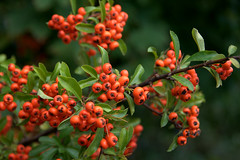
I ended up on the #92 bus. It was very confusing as the bus driver did not speak a single word of English and there was no signage, that I could find, explaining anything at all about how the bus worked. It was mostly empty and I really did not know where we were going so I just rode along.
I started to get a little worried when the bus took me out into the countryside. This was not was I was looking for. I was trying to go to the train station in downtown.
The bus ended up taking me to a dead end street miles out into the country and kicking me off there. End of the line I guess. The bus changed its bus number and just sat there fora while. I stood around for some time staring at the bus schedule trying to make sense out of it and eventually gave up and started walking. I had my mobile with Google Maps so I was not concerned about getting lost but just that this was going to eat up the entire morning.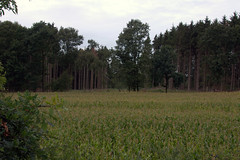
My walk back to where I started ended up being 3.2 kilometers. A good hike to start the day. And all of that time and energy and all I managed to do was to get back to the hotel where I started! I took lots of pictures on the way and the Nikon GPS unit worked like a champ. Now from Flickr you can generate a map displaying the route that I walked. Pretty cool.
I did managed to then catch another bus and that bus driver at least understood when I said “train station” and she nodded. That was all that she could speak of English as well, I think. I am pretty sure that avoiding the buses is the way to go. They are not at all used to shuffling tourists around and have no idea what to do with them. And the bus information is all in German or you are just expected to know it so it is even that much more confusing.
I did make it to the train station but once here, like everything else involving the buses, I could find nothing whatsoever that would inform me as to how to get to the Kalkriese from the train station. All of the guidebooks say to come here to get the bus going there but there was nothing anywhere with anything mentioning that site. Several people mentioned asking a bus driver but obviously that is not an option either. There is no information booth or other bus-related person working at the train station. This is crazy.
I finally gave up and paid a taxi about fifty dollars to drive me up there. That cut the travel time in half from what it is supposed to take the bus and my day was getting shorter by the minute so it did not seem like all that bad of a plan even though it was pretty expensive.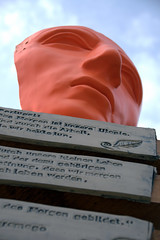
After all of the trouble and expense getting into the museum was just nine Euros or roughly fifteen dollars. Because of the anniversary there is a special exhibit called “Konflict” that shows northern European warfare through the ages. It was a good exhibit but almost entirely in German. The big items had English translations but none of the individual museum items. So I did not spend too much time there.
After going through the “Konflict” exhibit I headed out to see the battlefield itself and the archeological works. This is what I really came to see.
From the museum area you pass through a small sliver of trees maybe fifty feet deep and then you step out into the clearing. I believe that this area has all been cleared since the battlefield was discovered in the late 1980s and now is a very open location. The battle itself, though, would have taken place deep within the forest, I believe or, at least, in far more wooded conditions than exist today although some homes did exist on the spot as much as a hundred years prior to the battle taking place.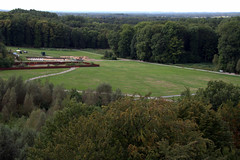
It is truly astounding to think of the thirty to forty thousand soldiers who lay buried here and even more amazing to think about this battle’s import on the world stage. Such a remote location. So forgotten. The battle was so poorly known that it was “discovered” in ancient texts by monks in the fifteenth century. The site was only discovered in the late 1980s and it has not been completely determined if the site at Kalkriese truly is the site or not although it is most likely to be it.
The battlefield is filled with large metal plates. I believe that these are to mark the progress of the Roman troupes as they marched through the forest. The entire museum complex is rather artistic in a very European way with a lot of abstract or semi-abstract memorials to the battle. At the opening of the clearing there stands a camera obscura. You can go into and and see the entire battlefield upside down and in miniature with tourists walking around. Rather strange. All of the museum buildings are made from rusted metal so it is all a dull orange.
Many of the plates have information written on them in German. Most everything at the museum is in German only so if you do not speak and read German much of it will be lost. There was an audio walking tour as well but as all of the information about it was in German I assumed that the audio was German as well and so did not bother to partake which is too bad as I am sure that it was very nice. Lots of people were using it. The people at the front ticket booth new that I was an English speaker and did not offer me the audio so I am pretty confident that it was not an option.
In the middle of the battlefield is live archeological excavation going on. There were probably ten people or so working. Some actively digging, some moving dirt around and some sifting through the sand looking for artifacts. It was interesting to see a real world dig. I have never actually seen one before in real life.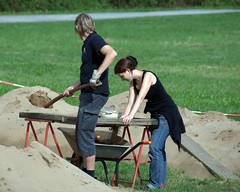
Beyond the dig was more of the battlefield and another freestanding exhibit – this one showing a movie about war between organized professional armies and civilians. A poignant and wordless reminder that this battlefield on which we are standing was fought between the world’s largest, most well trained, highly paid and insanely well equipped army’s most elite units and a group of farmers and light militia with little or no training, no money being spent and barely any weapons and likely no armour. These were incredible odds. The risk undertaken by the Germans was truly astounding. Not only could they have been wiped out right here at Kalkriese but the Romans would have been in a position to not only subdue but to depopulate Germania practically overnight. This was the ultimate gamble. It is no wonder that its ramifications arguably outweigh the outcome of any other military event in history.
The outcome of this battle, that happened right here under my feet, determined not only the outcome of a single war but fundamentally changed the global balance of power for the rest of history and wholly redefined Europe’s role in the world. One of the signs hanging at the Kalkriese says, roughly, “Celebrating European Freedom”. That is exactly what this battle represents. Free Europe. Had this battle swung the other way, had Arminius and his men fallen here instead of the Roman infantry, it is most likely that Rome would have run roughshod over all of Europe sweeping away people after people into one massive, totalitarian Imperium.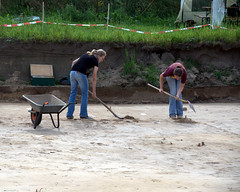
What would the world look like if Rome ruled Europe? What if European sensibilities about the immorality of subduing other peoples never emerged from a principle player in world events? Rome would have controlled its own most dangerous borders and been able to focus all of its energies like never before seen on eastern expansion into Persia, India and China. Given a Rome twice the size that it ever was, would any people have been able to withstand Rome’s staying power? A war of attrition with Rome would have been a losing war. Slowly but surely it seems that Rome may actually have conquered the known world. But this battle ended that dream for Rome and sent the message to the Caesar that the days of Roman expansion had ended and the fall was beginning. Caesar Augustus would lose his mind when he heard the news of the defeat – he, probably more than anyone, knew that once Rome stopped expanding it would begin dying. Rome’s entire economy and social order was based upon constant, never ending expansion through military dominance. Now Rome could not only not expand but it now lived in perpetual fear that Germania would itself begin the process of expansion with nowhere to go but south into Roman lands. It was now Rome who waited with baited breath for the day when an army would sweep down from the north to sweet it away. For the day that Germania decided that it would fight with an army instead of with farmers.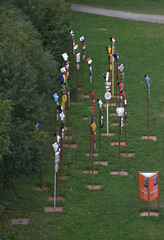
After walking the battlefield I went to the museum which is in a very modern structure that is so abnormal that I had a hard time figuring out that it was even the museum.
The museum was well done if small – there is only so much to show about a battle about which we know so little. There were several exhibits of finds from the site just outside and lots of history lessons on the walls around the museum. Much here was in English but still much was not.
One really neat exhibit was a tiny scale army, made using little lead miniature common in war gaming (the same scale made popular but Dungeons and Dragons and similar games) with literally a one to one representation of what we believe that the Roman army marching through Kalkriese would have looked like including the marching order. It was massive. Looking at the troops in that way really put into perspective the scale of the battle. The lines would have stretched for miles it seems. Capturing them and holding them in Teutoburger Wald must have been a serious challenge for the Germans.
There was another exhibit where the question is posed, “If the 26 year old Arminius and the 51 year old Varus, who had known each other in Rome, were to face each other today, what would they say?” Since the two leaders knew each other and there is no record of there being ill blood between them we wonder what must have been going through their minds as they faced each other at Kalkriese. Arminius, having been taken captive as a child to Rome as an effective slave and separated from his family and his people, had every understandable potential to harbor a hatred of Romans that could not be overstated. The Roman plan of capturing important German children and raising them in Rome counted on Stockholm syndrome to kick in before the children were allowed to return to Germania as adults. Generally this worked. But, as we see here, it only has to fail once for the damage to be insurmountable. The wrath of someone made a slave is a significant potential and if Arminius dedicated his life to preparing for the moment when he could enact the most painful revenge we see the possibilities begin to form. A gambit of not epic but epoch changing proportions is something that only someone in this horrible position could really contemplate. And apparently he did. This was not a quick decision but a lifetime of planning and preparation coming together at a single moment – planning on a scale that even an empire like Rome could not attempt to replicate as only someone dedicating their entire life to the enterprise could truly be this prepared.
From the top of the museum building, roughly ten stories up, there is an observation deck that looks out over Lower Saxony and down at the battlefield giving you a complete view of the forest and the excavation site. Very cool.
I visited the museum gift shop and bought a baseball cap from the museum (I have been looking for a cap to buy since coming to Germany because I need one and we lost my old one) and also two books. One book is a tiny book in German that is a collection of all of the ancient texts talking about the battle. The second book is called “Arminius, Varus and the Battlefield at Kalkriese” which is an overview of the battle and talks about the work that is going on there – it is printed by the museum itself. There were tons of books at the museum that I would have really like to have purchased but they were expensive and I have no way to transport them home. These two were very small and I definitely wanted something from there as a permanent souvenir.
I learned at the shop that I had an hour and a half to wait until the last bus of the day would arrive to take people back to Osnabruck. I had come by taxi but had no real means of getting another taxi to pick me up. I had gone on the assumption that I would “figure something out” in order to get back. This was extra risky as my mobile phone was all but dead. I had left it off for most of the day just in case but after this morning’s problems I had used most of the remaining battery getting myself to Kalkriese in the first place.
So I took the remaining time and just walked through the woods at Kalkriese. There are paths going all over the place and some excavation work even out in the forest. It gave me a chance to just reflect on the day.
While waiting at the bus stop I had a chance to talk to an eighty year old German history buff. He had come in from Hanover today to go to the museum. He was the only person that I know came in for the anniversary. There were one or two others throughout the day that I suspected were there for the anniversary but this is the only one of which I was sure. There were a few hundred people at the museum today but mostly they were school groups on field trips (what a great field trip – I really hope that we get to bring Liesl here someday!) He did not speak much English but we tried and took some time to discuss the battle. It was nice having someone to talk to. I am pretty sure that I was the only non-German native who came out to Kalkriese today. That really surprises me. I would have thought that a handful of people from around the world, like me, would have taken the time to come in and honour this day. Am I really the only one?
The bus ride back took much longer than did the taxi ride but it only cost me about three Euro fifty (can that be right?) It was so cheap. I thought that it was going to be like eighteen Euro. I told the bus driver that I wanted to go to Neumarkt and he repeated it (one of the few place names that I know that I can get correct) and I have him a twenty and he gave me gobs of change. Maybe I just don’t understand how much it is supposed to cost. Anyway, its a bargain if you can figure out the bus. The buses are comfortable and clean too. Much like in England but only one deck.
I got a few pictures of the bus ride, mostly windmills in the country for dad. The Nikon D90 with the VRII on the lens really does do a great job of allowing me to handhold shots out of the windows. Quite impressive.
I never managed to figure out when we got to Neumarkt so I ended up riding to the end at the Hauptbaunhof which is only slightly farther away from the hotel. Maybe ten or fifteen minutes longer by foot.
From the Hauptbaunhof I walked to Neumarkt and on our to the west side of Osnabruck where the hotel is 4.1 kilometers. A pretty decent walk after my impromtu walk this morning followed by an entire day of walking around two museums and an entire battlefield over and over again. I estimate that I walked a minimum of five kilometers at Kalkriese and easily a lot more. I walked the perimeter, through the middle, on all kinds of paths, up the tower, around both museums and more mostly multiple times! I was there, on foot, for about four hours.
I took a lot of pictures on the walk back to the hotel. Nothing spectacular but I wanted to get a real cross-section of the city so that Dominica and other people back home could get a feel for what a real German city was like and not just pictures of important structures or famous places. Most everyone that I know is very interested to know what Germany is actually like. The real answer is that it is a lot more like home than you would think.
I did get to walk by Osnabruck University which, strangely enough, is located on Martinistraße – yes, the university is on Martini Street!! It is a really cool looking university. I got some nice pics of it.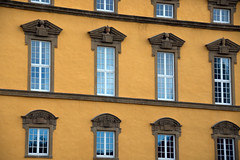
The sun was getting low when I got back to the hotel. I was exhausted. I have not slept for even seven and a half hours since leaving New York and I worked a full day before leaving New York! I have been awake with like eight o’clock on Tuesday morning and I have had the flu since arriving (I started getting the sniffles right as I left New York.) So I am really in rough shape.
I showered and caught up on stuff from the hotel room. Ended up doing some work, uploading some pics and working on SGL for a little bit before going down to the dining room and getting the cheese spaetzle again. I was so busy today that I had completely forgotten lunch and did not even realize. I only just made it for dinner before the kitchen closed! I had one sandwich in the airport in Dublin and have had just three meals since arriving in Europe – all three being at the hotel. I need to get out and eat some.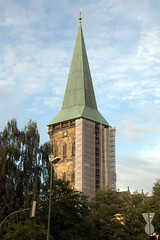
After dinner I went back up to the hotel room and managed to fall asleep for about fifteen minutes. That helped a lot but it also made me not so tired so I was awake for quite a bit longer. I ended up staying up until two in the morning talking to people and working on uploading pictures. I only just began to get them uploaded from all of the ones that I took today. I took almost two hundred and fifty pictures! It was quite a good haul, photographically speaking.
At two I was feeling just enough better after figuring out that drinking hot water was helping my congestion that I was able to put on my CPAP and after a few tries I fell asleep. Finally, real sleep. It has been a long, difficult but utterly memorable and very important day. Today was the reason that I made this trip and it worked out very well. I will definitely always remember coming to Germany and visiting Kalkriese on the 2,000th anniversary, to the day, of the Varusschlacht.